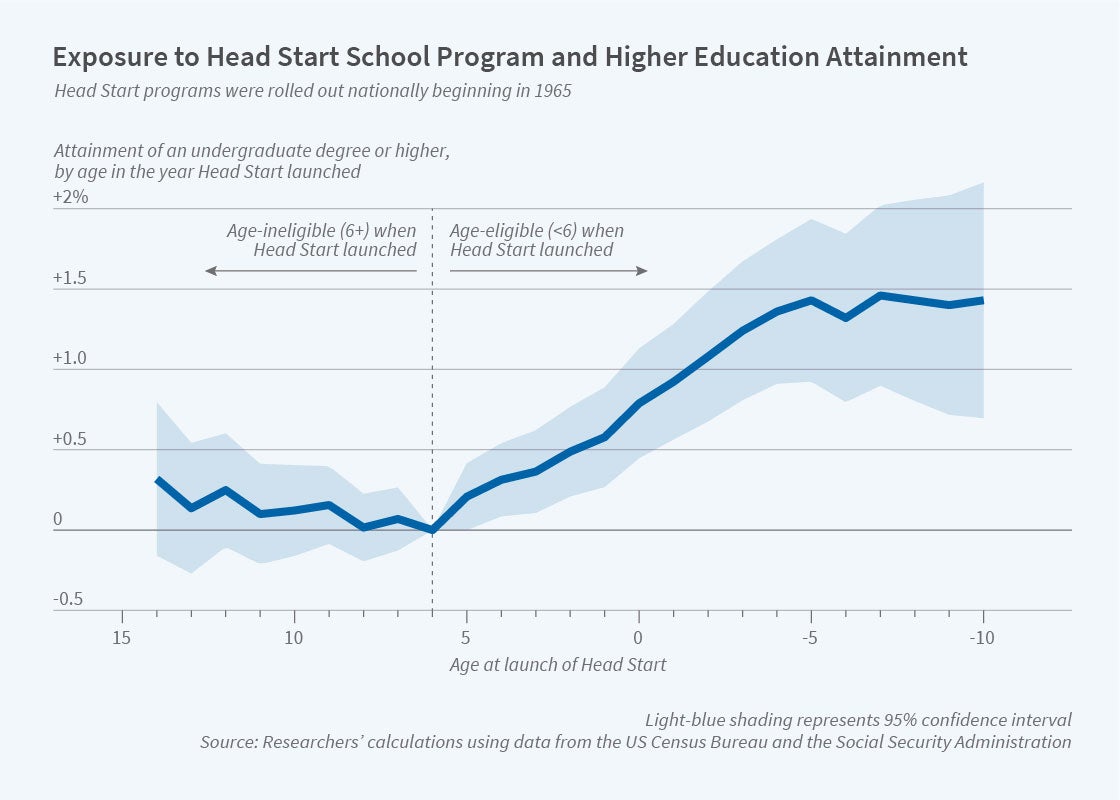Evaluating the Head Start Program for Disadvantaged Children

Low-income children who participated in Head Start were 2.7 percent more likely to finish high school, 8.5 percent more likely to enroll in college, and 39 percent more likely to finish college.
The Head Start program increases high school and college graduation rates and participation in the workforce, according to a new study by Martha J. Bailey, Shuqiao Sun, and Brenden D. Timpe.
In Prep School for Poor Kids: The Long-Run Impacts of Head Start on Human Capital and Economic Self-Sufficiency (NBER Working Paper 28268), the researchers estimate how the federal preschool program altered participants’ life trajectories.
Launched in 1965, Head Start takes a multipronged approach to enriching young lives. In addition to building academic and interpersonal skills, it addresses health by providing nutritious meals, vaccinations, and screenings for childhood diseases and vision and hearing problems. It also encourages parental involvement and connects families to social services.
Head Start served about 20,000 children in 1965, and nearly 260,000 by 1970. Three-quarters of the beneficiaries were not White, and 62 percent came from families with less than $4,000 in annual income.
The researchers analyze data from the US Census Bureau and the Social Security Administration. Their sample includes 22.5 million children born between 1950 and 1980 when they were aged 25 to 50, from 2000 to 2018. By including cohorts before the advent of Head Start, the researchers are able to rule out factors that may have influenced trends in particular counties. Using birth county and date-of-birth data, they measure childhood access to Head Start, while controlling for state-level economic and policy changes that could have influenced outcomes independently of the program. While the dataset does not identify individual Head Start participants, it allows for measurement of exposure. To estimate the impact of the program, the researchers compare adult outcomes for cohorts of Head Start-eligible children (ages 5 and under) with cohorts of those who were ineligible (ages 6 and over) as the program rolled out at county level from 1965 to 1980.
They find that children who participated in Head Start were 2.7 percent more likely to finish high school, 8.5 percent more likely to enroll in college, and 39 percent more likely to finish college than were their ineligible counterparts. Head Start decreased the likelihood of adult poverty by 23 percent and dependence on public assistance by 27 percent. Participants were 4 percentage points (5 percent) more likely to have been employed, and they spent on average two more weeks working in a given year than comparable individuals in ineligible cohorts.
The researchers suggest that Head Start may have influenced women and men in different ways, noting that its “effects on [a woman’s] human capital may have helped her marry a higher-earning spouse and, potentially, work less for pay and more in the household.” They find that Head Start reduced poverty rates among women by 31 percent.
They also note that the program may have contributed to the building of healthier, better-educated communities, but they have not attempted to quantify those effects.
— Steve Maas


